Ventilation in houses with gas stoves: rules and regulations for organizing stable air exchange
The desire to save on utility costs is common to most of us.And you must agree that switching to the use of natural gas for cooking and heating is the most optimal way of such frugality. But ventilation in houses with gas stoves must be built according to very strict rules.
You will learn everything about the requirements for installing a kitchen exhaust system in our article. We will introduce you to the regulations of the regulatory documentation, covering in detail all aspects of this difficult issue. Let's look at standard options for organizing an air mass removal system.
The content of the article:
Air exchange standard requirements
When designing ventilation in kitchens with gas stoves, it is necessary to comply with the requirements of both sanitary and fire safety standards (GOSTs, SNiPs, SanPiNs and SP). Gas supply to apartments and cottages is an undoubted benefit, as it can significantly reduce utility costs. But there are a number of points.
Both delivery options: transported by pipes main gas and LPG from a gas holder or cylinder is a source of danger. It is impossible to neglect the regulations and forget about safety rules.

If the exhaust and air supply in a gasified kitchen room are not organized correctly, the room can become a source of serious problems associated with open fire and a possible explosion of “blue fuel”.
Gas stoves are allowed to be installed both in private houses and in apartment buildings. The height of the building can be no more than 10 floors. In this case, the premises for them must have a window and be well lit by natural sunlight.
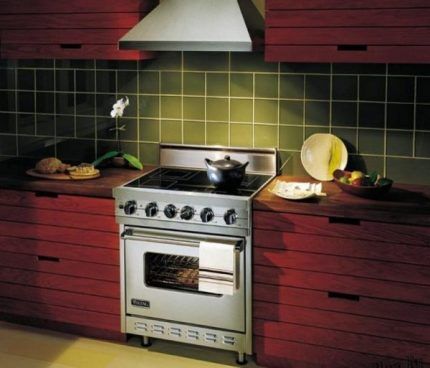
A kitchen for installing a gas stove must:
- be with ceilings with a height of 2.2 m and higher;
- have ventilation with natural air inflow/removal;
- have a window that has an opening sash or a transom or window at the top.
The cubic capacity of a room with a household gas stove should be at a minimum (or better yet, more):
- 8 m3 – with two burners;
- 12 m3 – with three burners;
- 15 m3 – with four burners.
In some cases, it is permissible to slightly deviate from these standards, but only if such deviations are agreed upon with inspectors from the Ministry of Emergency Situations and other regulatory authorities.
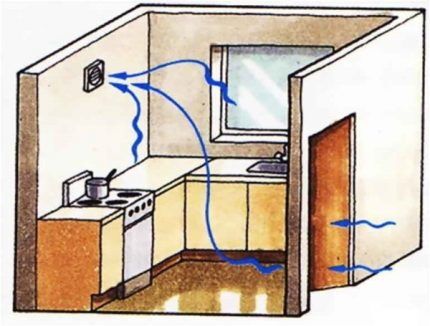
When organizing air exchange in the kitchen It is important to ensure that new air comes exclusively from the street. This will prevent air masses with excess odors and moisture, as well as low oxygen content, from entering the kitchen area. Methane or propane-butane alone is not enough for a gas stove to work.
The air exchange rate for a kitchen with a gas stove is 100 m3/hour. Moreover, in most apartment buildings, ventilation ducts with a width of 130–150 mm of the general ventilation system are designed for a flow of up to 180 m3/hour.
It is only necessary to ensure the required air flow from outside.In a private house, everything depends on the project. Here you need to look at a specific example to see what the existing ventilation system.
Organization of ventilation for a gas stove
Ventilation in a kitchen where a gas stove is installed can be:
- with compulsion
- with natural urge;
- combined.
Any option is allowed. However, according to fire safety standards, the air exchange in the room in question must be natural. A forced system with a fan is volatile and can only be used as a supplement.
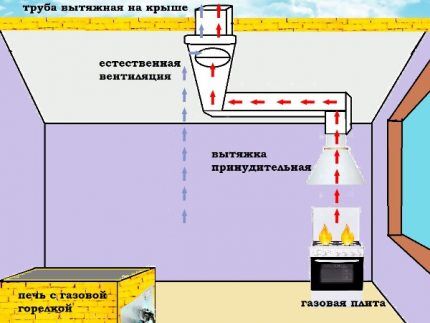
If you place it in the kitchen hood with fan and outlet to the riser, then for its proper operation:
- it is necessary to ensure the proper volume of air flow into the room;
- it is prohibited to close the ventilation duct with natural ventilation with a new outlet pipe;
- it is necessary that the ventilation riser be able to pass the volume of air blown into it.
If the ventilation is rebuilt for a gas stove in a cottage, then there will be a minimum of problems with the expansion and reconstruction of ventilation ducts. All you need is money and time to work.
But if a gas stove and ventilation for it are installed in an apartment in an apartment building, then the situation is often dire. Not every high-rise building, if it is not initially included in the project, is designed for the installation of gas-powered equipment.
At a minimum, you will have to install window and wall valves for additional flow of outside air. Standard ventilation ducts and existing supply openings are unlikely to be designed to meet the required parameters.
What can and should be done?
If the existing ventilation system is capable of providing an air exchange of 100 m3/hour, then you just need to install a cooking stove and connect it to gas. And you can start preparing your own food. Otherwise, when installing a gas stove, the ventilation in the apartment and cottage will have to be modified in two directions - the first is inflow, and the second air exhaust.
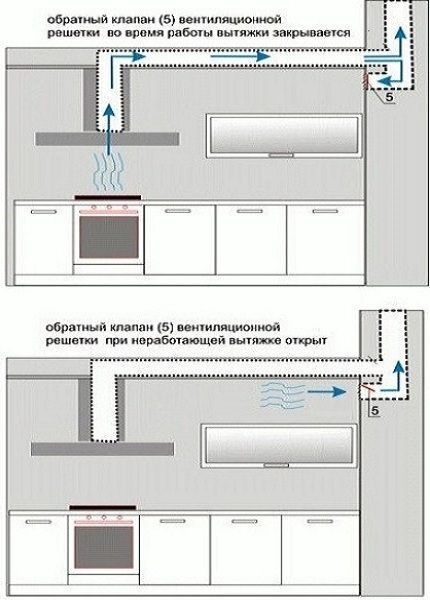
Additional air flow is provided by:
- drilling a hole in the street external wall and installing a ventilation valve in it;
- installation of supply valves on kitchen windows;
- increasing the clearance under the door to the kitchen.
In the general situation, air flow is provided from the street and from other rooms of the house. But in the case of a kitchen and a gas stove, most of it should go outside.
It is acceptable that it comes from a window in the bedroom or living room, but then the clearance from the flooring under the kitchen door will need to be larger than the standard 15–20 mm. Here the door leaf will have to be raised by 20–30 mm. If you mount it lower to the floor, the air exchange will be insufficient.
It is recommended to make supply valves in a wall version. In cold weather, window analogues can freeze and stop providing air flow. In-wall options are larger and free of icing problems.
If the house is old, then without installation of supply valves not enough. Soviet-built buildings were initially designed for ventilation due to the natural flow of air through loose doors and wooden windows.
However, now double-glazed windows and doors with seals are installed everywhere. As a result, the air exchange standards laid down in the project are violated everywhere, often due to simple ignorance.
As a result, the ventilation system is already unable to cope with the task, and a gas stove is added, which requires additional volumes of oxygen to operate. Without supply valves air, it is often impossible to provide the proper microclimate in residential premises in this case.
What is prohibited?
In old houses, ventilation ducts were often made using wood parts. Plus, they may contain cables for power supply and/or communication systems. It is prohibited to route the outlet from the hood above the gas stove into such shafts.
Combustion products from a gas furnace have an elevated temperature and also contain water vapor, CO and CO2. You cannot pull such a cocktail into a ventilation duct that is not intended for this purpose.

On the one hand, ventilation ducts in a kitchen with a gas stove must ensure proper air exchange, and on the other hand, exclude the possibility of fire from combustion products of natural gas.
Another point is the purchase and installation of a forced-air hood-umbrella in the kitchen. Sellers of such equipment praise their product and recommend purchasing more powerful equipment for 900–1100 m3/hour. However, more power in this situation is more of a harm than a benefit.
If the ventilation hole in the wall and the riser shaft are designed for a passage of 180–200 m in diameter3/hour, then they won’t physically allow you to pump much more through themselves.
Even if the “umbrella” hums at full power and pushes a larger volume of air, the channel will not be able to pump it. As a result, either the “hood” will run idle, or a reverse draft will form in the shaft. Both options are of no use.
Difficulties often also arise when the apartment is located on the top floor of a high-rise building. In such a situation, the ventilation in the kitchen often works poorly. The diameter of the ventilation duct allows for natural air exchange at the proper level, and there is practically no draft.
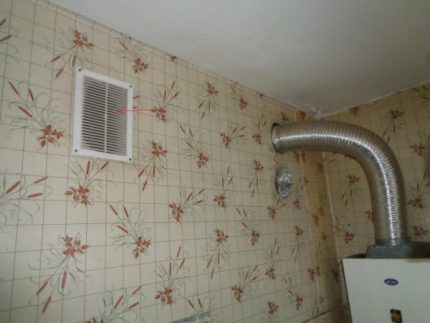
In order for the required draft to be generated, the air flow from the room must enter a vertical pipe, and then pass through it unhindered for at least 2 meters. However, on the top floor, the kitchen vent is located near the ceiling and does not provide the necessary clearance.
There is only the attic above and less than half a meter remains to the end of the ventilation shaft, which ends there. As a result, air exchange occurs, but it is too small for a gas stove.
In this situation, you will have to install an additional vertical pipe of the required height, otherwise it will be impossible to meet the ventilation requirements in a room with a gas stove. Forced exhaust can solve this problem. But when the lights are turned off, the fan will stop working, which is already prohibited by fire regulations.
Conclusions and useful video on the topic
Rules for choosing a forced draft kitchen hood:
Successful design of a homemade hood for a gas stove:
The most typical violations in ventilation systems in kitchens with gas stoves:
To prevent a kitchen with a gas stove from becoming a fire site, the ventilation system in it must be natural and comply with the requirements of SNiPs for air exchange rates per hour.
And when installing an additional hood, we must not forget about ensuring proper air flow from the street. Due to its low cost, natural gas allows you to save money, but it is difficult to call it completely safe. You should not ignore the instructions of fire safety and sanitary standards.
Please leave comments in the block below, post photos related to the topic of the article, and ask questions. Share your experience gained while installing ventilation in a gasified kitchen. Tell us about technological nuances that will be useful to site visitors.




When building my house, do I need to coordinate the ventilation design with someone?
Hello. For a private house, you do not need to coordinate the design of the ventilation system in any structures. But if you want the ventilation to function properly, then the design must be in accordance with SNiP.
Many people skimp on ventilation when they build a house, but in reality, getting a ready-made ventilation project for your home is not that expensive. Taking into account, of course, that you will implement it yourself.
The project includes:
- technical task;
- detailed explanatory note;
— formulas and calculations;
— detailed drawings of the ventilation system. systems;
— specification for recommended equipment;
— feasibility studies based on which equipment was selected.
If you want to draw up and calculate the project yourself, then the simplest formula is based on the number of people.
Very interesting article. Just not a single reference to regulatory documents where all this can be specifically clarified and read. What channels should there be, what diameter, how to calculate the required air exchange. Depending on this, how to choose a supply ventilation valve for the wall or for the windows, and so on.
I completely agree with Dmitry’s comment. We are now working in an apartment building (for 2 weeks now) to replace all the gas pipes inside the apartment and in the building, and there is no design, permit, admission, etc. - no, there is nothing at all and the foreman says we have nothing to do with Mosgaz. Moreover, the replacement of gas pipes occurs with a decrease in all diameters (riser pipes and intra-apartment pipes), changes in planning and architectural solutions. So the norms are still not for everyone. And most importantly, there are no “ends” to be found.
And the article is good, but without references to norms (at least general ones) it’s not even lecture material.
Hello. The apartment is on the top floor, the double-circuit boiler blows ventilation into the apartment and does not blow it out. There is no inflow. There is a bathhouse in the apartment. What do you advise
I agree with the material. From experience in operating and maintaining geysers:
1. Modern plastic windows and doors cause HSV failure. The traction sensor is activated. The consumer is at a loss: the new column is faulty! It is very important, especially on old-style HSV, where the sensor is not installed or faulty, to independently check the draft before turning it on.
2 Signs of lack of traction:
— stuffy air in the room;
— headaches among residents;
—- domestic birds die for no reason;
—- melting of the plastic ceiling covering.
The BEST method for checking draft is to place a sheet of newspaper against the open window of the chimney shaft. At the same time, it should press against the wall with a pop. If it is not held, the thrust is zero!
Hello, we bought an apartment above a gas stove and want to install a hood. Questions:
1. The exhaust hood in the house is a supply and exhaust system, but I don’t know whether it is a separate ventilation duct or not.
2. Is it possible to install a ventilation duct from the slab under a suspended ceiling?